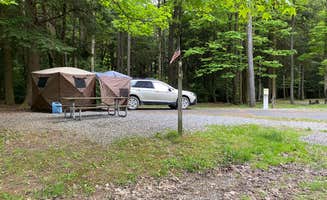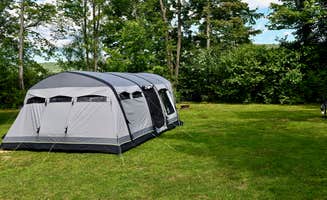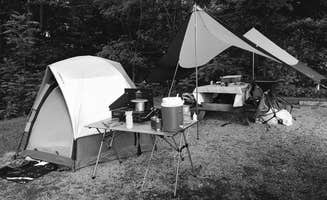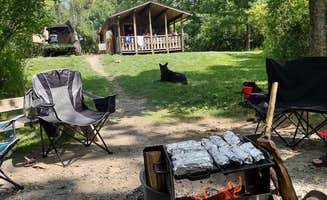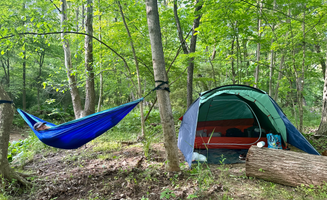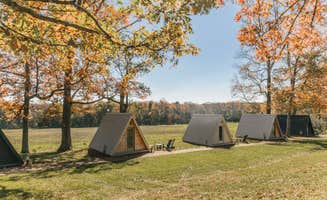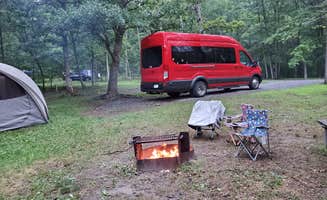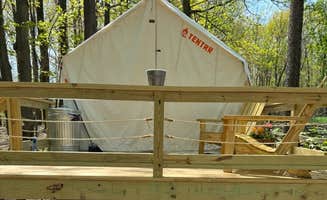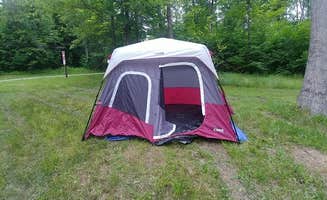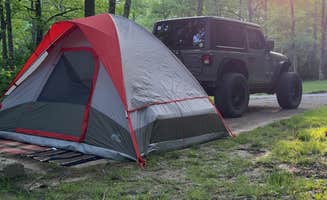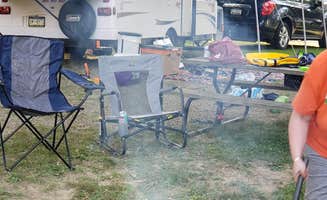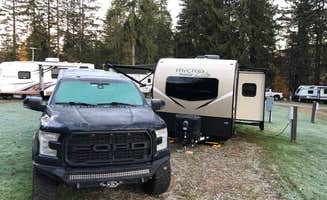Camping spots near Parkhill, Pennsylvania spread across the Laurel Highlands region at elevations between 1,200-2,900 feet, creating temperature variations that can be 10-15°F cooler than surrounding areas. The region's waterways include lakes formed by flood control dams constructed in the early-to-mid 1900s. Western Pennsylvania campgrounds typically operate from mid-April through mid-October, with some facilities remaining open year-round with reduced amenities.
What to do
Swimming and beach access: Quemahoning Family Recreation Area offers a beach area within easy walking distance from campsites. "Easy walk to beach area and boat launch. Very clean," notes Paul B. The swimming area sits along the shore of Quemahoning Reservoir.
Mountain biking: Trails near Blue Knob State Park Campground provide challenging terrain for cyclists of various skill levels. "Bike trails come directly through the park making it simple to go for a ride but the trails are not for the weak. Lots of climbing or descending and fairly rocky," explains Travis S. Blue Knob contains Pennsylvania's second-highest peak with multiple trail connections.
Fishing: Multiple campgrounds provide fishing access, with Quemahoning Family Recreation Area receiving consistent praise. "Great place for fishing kayaking. Very family oriented," states Kyle K. Campers can fish from shorelines or use electric-only boats on certain lakes.
What campers like
Waterfront sites: Mirror Lake RV Camping & Fishing provides sites with water views that campers consistently mention in reviews. "The location on the water adds for a great view," writes Theodore C. Many sites allow campers to enjoy lake views directly from their camping spot.
Affordable boat rentals: Laurel Hill State Park Campground offers reasonably priced watercraft rentals. "Kayak rental of $15 for an hour was the cheapest we have seen and allowed us to explore more of the lake," says Erik E. The park maintains rental operations during peak season from Memorial Day through Labor Day.
Site privacy: Several campgrounds offer secluded sites away from crowds. At Blue Knob State Park, "it's small, with shaded sites around the perimeter and two walk in sites just left of the entrance," notes Travis S. The campground's smaller size contributes to a quieter experience compared to larger facilities in the region.
What you should know
Site limitations: Many campgrounds have challenging terrain for tent placement. At Laurel Hill State Park, one camper noted: "Unfortunately, it was not great for tent camping as there wasn't really a spot to set up our 4-person tent. We squeezed it in by the fire pit, but if we had wanted to use the fire pit it would have been a fire hazard."
Limited cell service: Connectivity varies significantly throughout the region. At Blue Knob State Park, visitors should "be prepared for extremely limited cell service (Verizon)," according to Olivia L. Higher elevation campgrounds often have better reception than those in valleys.
Weather variability: Yellow Creek State Park and similar highland campgrounds experience significant temperature drops after sunset. "The creek surrounding the island does make it cold at night so make sure to pack warmly," advises Abigail about Yellow Creek's island campsite. Temperature drops of 15-20°F between daytime and nighttime are common.
Tips for camping with families
Beach alternatives: Prince Gallitzin State Park's Crooked Run Campground offers family-friendly water access. "Great camp sites and friendly staff," notes Joseph H. The campground includes a designated swimming area separate from fishing zones.
Activity options: Several parks provide diverse recreation beyond just camping. "Great for families to get away. Quiet and scenic, great trails. Close to lake and fishing," writes Natalie L. about Laurel Hill State Park. The park includes volleyball courts, shuffleboard, and geocaching opportunities.
Bathroom facilities: Bathroom quality varies across campgrounds. Mirror Lake campers noted: "The cabin was great, very clean and cozy. The campgrounds are very nice they have a pool as well as a community building and camp store." When camping with children, facilities with updated restrooms provide greater comfort for multi-day stays.
Tips from RVers
Site selection: Shawnee State Park Campground requires careful site selection for larger rigs. "We have a 35' TT and there was no way it was going to fit in the site we originally booked. Luckily it was opening weekend and the rangers and super accommodating! We moved over one site and it made all the difference," shares Brittany V.
Hookup access: Electric connection placement requires planning at some campgrounds. At Laurel Hill State Park, "The electrical hookups are not played out well like an expensive RV park with the shared power post on the entrance side of the camper. You may want to have an extension for your power cable," advises Erik E.
Leveling challenges: Campground terrain often requires additional equipment. "RV sites are on a major slope, especially the pull-through sites," notes Kathy L. about Laurel Hill State Park. Carrying extra leveling blocks helps address the uneven terrain common at state park campgrounds in the region.


